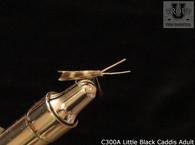 Little Black Caddis General Information:)
Little Black Caddis General Information:)
The little black caddis hatch is an important hatch due to the fact that the pupae swim up to the surface when emerging causing the hatch to look very much like the typical mayfly hatch. The caddisflies hatch will usually take place in relative smooth portions of water.
The hatch will start usually in the early afternoon hours often lasting until the late afternoon hours. Usually, but not always, the hatch is still going on the female adults will start to deposit her eggs on the surface film of the water.
The trout create a feeding frenzy once this activity commences. As they hatch on the surface, they shed the thin pupa skin and start to dry their wings. Note that the shedding of the skin enables the wings to become strong enough to fly away to the foliage beside the stream. The process of ascending to the surface and shedding the skin causes them to change into an adult and this process makes them vulnerable to the trout. The trout will gorge themselves at this time.
As the trout feed, they take the pupae just below the surface and you might see a slight swirl on the surface of the water. However, sometimes you might miss the slight effects on the surface, none the less, be assured it is happening if the trout are present. We believe that more little black caddisflies are eaten in the pupae stage than are eaten as adults.
Pupae Presentation Information:
The little black caddisflies pupae usually hatch in the slower, smoother areas of the stream such as pocket water. Using the up and across stream presentation would be appropriate for the pupae imitation fly. It is suggest that you will do somewhat better fishing upstream because you will get closer to the feeding trout.
Using either the across stream or the downstream presentation will be effective if you duplicate the pupa swimming to the surface to hatch. To duplicate this action, stop the rod near the end of the drift, allowing the fly to rise up to the surface. Let the current at the end of the line, bring the fly to the surface much the same as the rinsing pupa.
The caddisfly hatch can be detrimentally affected by the early heavy spring rains in the freestone streams of the Southeast USA like the Great Smoky Mountains, however, it still remains the most important early season hatch.

See the new double sided fly boxes.
Bait/Lure Type:
Equipment:
Techniques:





